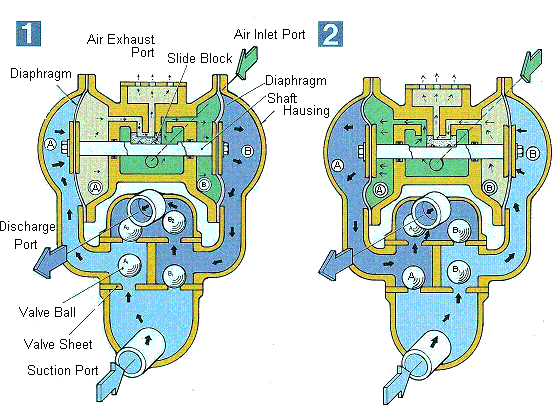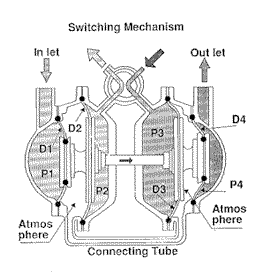Principle of Operation
Functions and structures
-
Our pumps are activated by compressed air and required
air pressure is designed within the range of between 0.05 Mpa2
and 0.7 Mpa2 in case of diaphragms other than TeflonR.
When air is fed to pump, it inhales and discharges, and pump will keep activating unless discharge port is closed or supplied air is stopped.
Discharge rate is determined by volume of air supply and discharge pressure of liquids.
Besides discharge rate varies widely depending on viscosity of liquid, gravitation and thickness of slurry.
Small bore of suction port or long suction port (though it is thick) would affect discharge rate badly (sharp decrease of discharge), thereby causing a dry run.
Grounds for obtaining tantamount to driven air pressure
- On Chart 1, compressed air
is supplied, through the channel :
 , into
air chamber B, and pushes the
diaphragm to the right.
, into
air chamber B, and pushes the
diaphragm to the right. - So does the connecting shaft to diaphragms, liquid chamber A will be discharge pressure. Ball A1 will be open and liquid chamber A is inundated. The discharges pressure of liquid chamber B closes Ball A2.
- The moving diaphragms charge pressure against the liquid chamber B. It will close Ball B1 and will open Ball B2, so that discharges the liquid out.
- Then air in the air chamber A,
through the channel :
 , is exhausted
out.
, is exhausted
out. - On Chart 2, slide block which connected shaft swiches section, Chart 1 to Chart 2, liquid chamber A takes the part of liquid chamber B. So do the balls.
These operation comes over and over to repeat Suction and Discharge.

Grounds for obtaining double discharge pressure with 2:1 ratio
-
We made area ratio 2:1 between diaphragm D2, D3 at
the operation side and the one of D1, D4 at the liquid side, which
has resulted in doubling the discharge pressure against the supplied
air pressure.
Moreover, should the diaphragm at the liquid sideD1, D4 be ruptured, we have set up the atmospheric space liquid chamber P1, P4 and air chamber P2, P3 to set in a safety apparatus so that the operation of pumps can be stopped inundating the liquid to the opposite space by connecting pipe without filling the liquid into the switching section.


